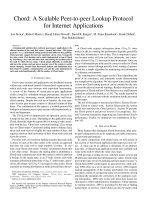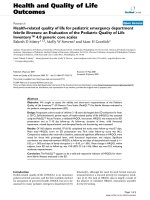oklahoma-protocol-for-pediatric-amplification
Bạn đang xem bản rút gọn của tài liệu. Xem và tải ngay bản đầy đủ của tài liệu tại đây (140.2 KB, 13 trang )
WATER
The following recommended protocols were developed by the Oklahoma Newborn Hearing Screening
Program (NHSP) in collaboration with the Oklahoma Audiology Taskforce (OKAT). These guidelines
were created in accordance with recommendations made by the American Academy of Audiology (AAA)
and the American Speech-Language-Hearing Association (ASHA). The protocols take into consideration
other national organizations such as the Food and Drug Administration (FDA), the Center for Disease
Control (CDC), Early Hearing Detection and Intervention (EHDI) Program, and the Joint Committee of
Infant Hearing (JCIH). Please reference those materials for further reading.
Protocols are to be implemented by individuals licensed by the State of Oklahoma to practice
audiology.
The two protocols included in this packet are as follows:
The OKLAHOMA PROTOCOL FOR PEDIATRIC AMPLIFICATION was developed to ensure
that Oklahoma children will receive full-time and consistent audibility of the speech signal at safe
and comfortable listening levels.
For electronic versions of the protocols or if you have additional questions or comments for the OKAT
Protocols Subcommittee, please email
Sincerely,
Patricia Burk, M.S., CCC-SLP, LSLS Cert. AVT
Facilitator, Oklahoma Audiology Taskforce (OKAT)
Program Coordinator
Newborn Hearing Screening Program
Oklahoma State Department of Health
OklahomaProtocolforPediatricAmplification
Debbie Earley, M.S., CCC-A
Facilitator, OKAT Protocols Subcommittee
Follow-up/Audiology Coordinator
Newborn Hearing Screening Program
Oklahoma State Department of Health
Page1
CONTRIBUTORS
The following is a list of contributors to the OKLAHOMA PROTOCOL FOR INFANT
AUDIOLOGIC DIAGNOSTIC ASSESSMENT and The OKLAHOMA PROTOCOL FOR
PEDIATRIC AMPLIFICATION. Contributions consist of writing, reviewing, modifying, and
approving these documents:
Christi Barbee, Au.D., CCC-A, F-AAA, Clinical Assistant Professor, Board Certified Audiologist,
OUHSC College of Allied Health Department of Communication Sciences and Disorders
Brooke Bennett, Au.D., CCC-A, Audiologist, Hearts for Hearing
Patricia Burk, MS. CCC-SLP, LSLS, Cert. AVT, Program Coordinator, Newborn Hearing Screening
Program, Oklahoma State Department of Health
Joan Burns, MA, CCC/A, Audiologist, The Scholl Center for Communication Disorders
Teresa H. Caraway, Ph.D., CCC-SLP, LSLS Cert. AVT, Co-Founder, Hearts for Hearing
Deborah Earley, M.S., CCC-A, Follow-up/Audiology Coordinator, Newborn Hearing Screening
Program, Oklahoma State Department of Health
Allison Finch, M.S., CCC-A, Audiologist, Children's Medical Center, LINK Project OSU-Tulsa
Meredith Gatzemeyer, Au.D., CCC-A, Audiologist, The Scholl Center for Communication Disorders
Mary Hudson, Ph.D. CCC-A, Assistant Professor/AuD Program Coordinator, OUHSC College of
Allied Health Department of Communication Sciences and Disorders
Heather Kasulis, Au.D., CCC-A, Audiologist, Hearts for Hearing
Beth Martin, M.S., CCC-SLP, Acting Chief, Child Guidance Service, Oklahoma State Department of
Health; DSHPSHWA Representative to the Joint Committee on Infant Hearing (JCIH)
Kela Miller, Au.D., CCC-A, Audiologist, Integris Cochlear Implant Clinic
Sandra Over, Au.D., CCC-A Clinical Audiologist Manager, Integris Cochlear Implant Clinic
Sandra Parke, Au.D., Audiologist, Koweta Indian Health Facility
Jacque Scholl, Au.D., CCC/A, FAAA, Audiologist, The Scholl Center for Communication Disorders
Miranda Seal, Au.D., F-AAA, CCC-A, Manager of Audiology/ENT for Chickasaw Nation Division
of Health, Chickasaw Nation, Indian Health System
Casey Smith, MPA, Quality Assurance/Data Coordinator, Newborn Hearing Screening Program,
Oklahoma State Department of Health
T.Tate Bay, M.S., CCC-A, Audiologist, Allergy Ear Nose and Throat
Brandon R. Vincent, Au.D., CCC-A, F-AAA, Staff Audiologist, Speech-Language Pathology
Department, University of Central Oklahoma
OklahomaProtocolforPediatricAmplification
Page2
OKLAHOMA PROTOCOL FOR
PEDIATRIC AMPLIFICATION
Revised: September 2010
The following recommended protocols were developed by the Oklahoma Newborn Hearing Screening
Program in collaboration with the Oklahoma Audiology Taskforce (OKAT) to ensure that Oklahoma
children will receive full-time and consistent audibility of the speech signal at safe and comfortable
listening levels. These guidelines were created in accordance with recommendations made by the
American Academy of Audiology (AAA) and the American Speech-Language-Hearing Association
(ASHA). Please reference those materials for further reading.
I. PROFESSIONAL QUALIFICATIONS FOR PROVIDERS FITTING PEDIATRIC
AMPLIFICATION
Special Note: A licensed audiologist is the professional qualified to select and fit amplification
devices for children, including personal amplification systems, cochlear implants, frequency
modulation (FM) systems, and other hearing assistance technologies (HATs). An audiologist who
does not have the expertise and/or equipment necessary to evaluate infants and young children should
refer to professionals and facilities that provide pediatric hearing aid services.
A. The audiologist should have experience with the assessment and management of infants and
children with hearing loss and the knowledge and test equipment necessary for use with current
pediatric hearing assessment methods and hearing aid selection, verification, and validation
procedures.
B. The audiologist should complete the procedures as described in the Oklahoma Protocol for Infant
Audiologic Diagnostic Assessment. For a copy of the protocols, contact the Oklahoma Newborn
Hearing Screening Program.
C. The audiologist should respect individual family choices and provide unbiased information
regarding communication options.
D. The audiologist should provide guidance, education, and training for families to help their child
reach their full auditory potential.
II. CRITERIA FOR PERSONAL AMPLIFICATION
A. Special Note: The decision for amplification should be based on many factors: the child’s
audiological data, speech and language development, home-based/center-based/natural environments,
family preferences and the existence of other medical conditions or special needs. For families
electing amplification, the audiologist should provide infants and children diagnosed with permanent
hearing loss with an amplification device within one month of diagnosis. Hearing aid features and
prescriptive settings can and should be modified as information about the infant’s hearing levels or
status is regularly updated.
A. Considerations for Amplification
1. If the child has a permanent, bilateral hearing loss, with thresholds of 20dBHL or greater in
any frequency considered critical for speech understanding, amplification should be
considered and not be delayed for concurrent medical and/or developmental conditions.
2. All hearing aid fittings for binaural hearing loss should be binaural unless there is evidence,
over time, of no benefit in one ear.
OklahomaProtocolforPediatricAmplification
Page3
3. If the child has a unilateral hearing loss with measurable hearing in the affected ear,
amplification in this ear may be beneficial. If further testing indicates that the ear with the loss
is unaidable, alternative amplification strategies and hearing assistance technologies such as
FM or Bluetooth systems should be considered.
4. If the child has a unilateral "unaidable" hearing loss, a bone anchored hearing aid on a
headband may be recommended up to age 5. After age 5, an implantable device can be
considered under consultation with a physician who specializes in ear pathologies.
5. If the child has an unusual configuration of loss or unusual type of loss (e.g. cookie-bite
configuration, auditory dysynchrony, etc.), the need for amplification should be made on a
case-by-case basis.
6. Middle ear status must be considered and periodic immittance testing is recommended using
age-appropriate immittance protocols. Infants with chronic middle ear conditions should be
referred for medical treatment; however, fitting of amplification and referral for early
intervention should not be delayed while waiting for resolution.
7. Infants identified with hearing loss who experience a long hospital stay should be fit with
appropriate amplification as soon as medically feasible, after appropriate clearance for
amplification use is received from the treating physician.
8. Fitting of amplification should not be delayed for:
a. certain medical issues, such as waiting for middle ear fluid to clear in the presence of a
sensory loss (pending medical approval).
b. financial reasons, as resources are available throughout the state for those families
waiting for insurance authorization or those who need assistance to cover the costs of
amplification. For a list of resources, contact the Oklahoma Newborn Hearing
Screening Program.*
B. National & State Recommendations
1. In accordance with the Food and Drug Administration (FDA) regulations, medical clearance
must be obtained within in the last six months prior to fitting hearing aids on children,
preferably by a physician who specializes in ear pathologies.
2. In accordance with the Early Hearing Detection and Intervention (EHDI) model of 1-3-6**, an
identified child will be amplified before six months of age.
3. In accordance with the Joint Committee of Infant Hearing (JCIH) 2007 Position Statement, the
fitting of amplification should take place within one month of diagnosis.
4. In accordance with the Oklahoma Protocol for Infant Audiologic Diagnostic Assessment, steps
should be followed in order to appropriately fit amplification.
III. PRE-SELECTION / PHYSICAL CHARACTERISTICS
A. Amplification Options
1. Behind-the-ear (BTE) aids are appropriate for most children. In-the-ear aids are not
recommended for use with infants and toddlers due to the rapid growth of the outer ear.
2. Hearing aids with digital signal processing are recommended due to their improved ability to
make soft speech audible, their flexible electroacoustic characteristics, and their noise
reduction algorithms.
OklahomaProtocolforPediatricAmplification
Page4
3. Hearing aids with multiple memories and remote controls can be considered for ease of
adjustment for the caretaker and for flexibility.
4. Infants need to hear environmental noise and distant speech from all directions to maximize
language and speech development and therefore, activated directional microphones are not
usually recommended for this population. Directional microphones, or dual microphones,
should be considered for toddlers and older children to improve the signal-to-noise ratio when
FM technology is not being used.
5. FM systems, coupled with personal hearing aids, are recommended for listening in noise
and/or at greater distances. Auditory trainers should be considered in an educational
environment when a personal FM system coupled with personal hearing aids is not utilized.
6. A bone conduction aid may be appropriate if the hearing loss is conductive and acoustic aids
cannot be used due to medical or physical contraindications.
7. Bone anchored hearing aids may be considered for children with hearing loss that meet
audiological and medical requirements. This may include conductive, unilateral, or mixed
hearing loss.
8. Cochlear implant(s) may be appropriate if the child meets audiological and medical
requirements.
B. Audio Input Features to be considered:
1. Direct audio input (DAI) capabilities
2. Telecoil
3. Microphone-telecoil switching option
4. Bluetooth
C. Safety Features to be considered:
1. Tamper proof battery doors
2. Programmably disabled volume control
3. Volume control covers
4. Water resistant
D. Earmolds should be:
1. Made of a soft material; hypoallergenic when appropriate
2. Replaced whenever feedback is excessive on optimal settings
3. Used with lubricants to help reduce feedback
E. Retention devices for amplification systems can include:
1. Ear retention rings
2. Toupee or wig tape
3. Cords or hearing aid retention clips
4. Headbands
F. Hearing Assistive Technology:
The purpose of devices such as FM systems or/and sound-field systems is to enhance the signalto-noise ratio by making the auditory signal greater than the background noise to facilitate
incidental learning in all environments. FM units are recommended for infants and children with
minimal to profound hearing loss (unilateral or bilateral) and children with auditory learning
problems.
1. Personal FM units
OklahomaProtocolforPediatricAmplification
Page5
a. A personal FM unit is the system of choice for hearing aid and cochlear implant users as it
retains the output and frequency response characteristics of the child’s device when
coupled with: direct auditory input boot, telecoil or loop, silhouette conductor, or ear
microphone.
b. Auditory trainers are utilitarian FM devices. Schools typically utilize this option when a
personal FM system is not available.
2. Sound-field FM Systems
a. The signal is picked-up by a receiver/amplifier and broadcast through speakers. These
speakers can be portable, wall, or ceiling mounted. These systems can be used
independently or in conjunction with hearing aids or cochlear implant.
G. Recommended Maintenance Kit items may include:
1. Desiccant kit
2. Cleaning tools
3. Battery tester
4. Listening stethoscope
H. Education materials must be given to caregivers including:
1. User manuals
2. Warranty and insurance information
3. Battery toxicity warning
4. Explanation of trial period
5. Oklahoma Board of Examiners for Speech Pathology & Audiology (OBESPA) contact
information
IV. ON-GOING VERIFICATION OF HEARING AIDS
A. Prior to direct evaluation of the hearing aid on the child, the instrument should be preset in a test
box to average age-related real-ear to coupler difference (RECD) values. The Desired Sensation
Level (DSL) v5.0 or most current available method calculated either manually or in computerassisted format is the approach of choice for the RECD procedure.
B. The preferred verification method for amplification is to use probe microphone measurements and
the child’s ear, earmold, and personal amplification system. The procedure should be combined
with a prescriptive technique that states target responses appropriate for the characteristics of the
amplification system (e.g. linear vs. non-linear, analog vs. digital).
C. Audiological assessment directly measuring the child’s performance should be completed
including aided soundfield responses to speech and frequency specific stimuli.
D. Verification reports should include hearing aid characteristics such as make, model, serial number,
input and tone settings, compressions or special feature settings, volume setting, earmold style and
quality of fit.
E. Electroacoustic and biologic verification should be performed:
1. On the day of fitting
2. One to three month intervals
3. Following any hearing aid repair
4. When parental listening checks and/or behavioral observations raise concerns
F. Suggested frequency of on-going verification:
1. Hearing aids should be evaluated every three (3) months until the child and parent are capable
of determining and reporting the status of hearing aids.
OklahomaProtocolforPediatricAmplification
Page6
2. Earmolds should be evaluated monthly as frequent earmold replacement may be necessary
during the first year of life. Thereafter earmold fittings should be evaluated at routine
audiological appointments or until growth has stabilized.
3. Immediate evaluation should be scheduled if parents or caretakers suspect a change in hearing
or hearing aid function.
V. AIDED AUDITORY SKILLS SHOULD BE MONITORED AND SHOULD INCLUDE:
A. Report and informal assessment by parent or caregiver
B. Functional auditory skill assessment obtained by the audiologist and early interventionist
C. Speech, communication and language skill assessment obtained by the early interventionist
D. Developmental input and recommendations by health care provider
VI. INFORMATIONAL COUNSELING AND FOLLOW-UP
A. Parents are the child’s best advocate and should be guided in the education and training for
working with their child with hearing loss to help them reach their full potential.
B. Information about all amplification options should be provided to parents.
C. Parents and other family members or all caregivers that assist in caring for the amplification
system should receive orientation and ongoing support as needed.
D. An audiologist should see the child at least every three months until hearing loss stability is
known. Thereafter, follow-up is at the discretion of the pediatric audiologist.
E. Follow-up appointments should include:
1. Behavioral audiometric evaluations
2. Adjustment of the amplification system based on updated audiometric information
3. Periodic electroacoustic evaluations
4. Listening checks
5. Check fit of earmolds
6. Periodic probe microphone measurements
7. Periodic functional measures to document development of auditory skills
8. Insurance options following warranty period for repairs and/or loss
F. An early interventionist should provide ongoing re/habilitation training aligned with the family’s
desired outcomes.
Footnotes:
* Oklahoma Newborn Hearing Screening Program can be reached at 1-800-766-2223 or
** CDC National EHDI Goals located at />These first three goals are frequently referred to as the 1-3-6 plan.
Goal 1: All newborns will be screened for hearing loss before one month of age, preferably before
hospital discharge.
Goal 2: All infants who screen positive will have a diagnostic audiologic evaluation before 3
months of age.
Goal 3: All infants identified with a hearing loss will receive appropriate early intervention
services before 6 months of age.
OklahomaProtocolforPediatricAmplification
Page7
APPENDIX A
From the Joint Committee on Infant Hearing, 2007
1. All infants should have access to hearing screening using a physiologic measure before 1
month of age.
2. All infants who do not pass the initial hearing screen and the subsequent rescreening should
have appropriate audiologic and medical evaluations to confirm the presence of hearing loss
before 3 months of age.
3. All infants with confirmed permanent hearing loss should receive intervention services before
6 months of age. A simplified, single point of entry into an intervention system appropriate to
children with hearing loss is optimal.
4. The EHDI system should be family centered with infant and family rights and privacy
guaranteed through informed choice, shared decision making, and parental consent. Families
should have access to information about all intervention and treatment options and counseling
regarding hearing loss.
5. The child and family should have immediate access to high-quality technology, including hearing
aids, cochlear implants, and other assistive devices when appropriate.
6. All infants and children should be monitored for hearing loss in the medical home. Continued
assessment of communication development should be provided by appropriate providers to all
children with or without risk indicators for hearing loss.
7. Appropriate interdisciplinary intervention programs for deaf and hard-of-hearing infants and
their families should be provided by professionals knowledgeable about childhood hearing loss.
Intervention programs should recognize and build on strengths, informed choices, traditions,
and cultural beliefs of the families.
8. Information systems should be designed to interface with electronic health records and should
be used to measure outcomes and report the effectiveness of EHDI services at the community,
state, and federal levels.
To view the complete statement, please visit the following:
/>
OklahomaProtocolforPediatricAmplification
Page8
APPENDIX B
Oklahoma Law and State Board of Health Rules
Oklahoma legislation originally enacted in 1982 and updated in 2000 requires that every newborn have
hearing screened before discharge from the birthing hospital. The legislation also required the State Board
of Health to develop rules and guidelines to accomplish the provisions of the act.
State of Oklahoma
Newborn Infant Hearing Screening Act
§63-1-543. Short title - Screening for detection of congenital or acquired hearing loss.
A. This act shall be known and may be cited as the “Newborn Infant Hearing Screening Act”.
B. Every infant born in this state shall be screened for the detection of congenital or acquired
hearing loss prior to discharge from the facility where the infant was born. A physician, audiologist or
other qualified person shall administer such screening procedure in accordance with accepted medical
practices and in the manner prescribed by the State Board of Health. If an infant requires emergency
transfer to another facility for neonatal care, such screening procedure shall be administered by the
receiving facility prior to discharge of the infant.
C. The State Board of Health shall promulgate rules necessary to enact the provisions of this act.
The State Commissioner of Health shall develop procedures and guidelines for screening for the detection
of congenital or acquired hearing loss.
D. Any durable medical equipment purchased or supplied by the State Department of Health for the
purpose of being permanently or temporarily fitted for use by a specific child shall not be deemed or
considered to be a “tangible asset” as that term is defined in Section 110.1 of Title 74 of the Oklahoma
Statutes and, once fitted to a specific child, shall be deemed thereafter to have minimal or no value to the
Department for purposes of further disposition pursuant to the Oklahoma Central Purchasing Act.
[1]Added by Laws 1982, c. 141, § 1, emerg. eff. April 9, 1982. Amended by Laws 2000, c. 204, § 1, eff.
Nov. 1, 2000; Laws 2006, c.273, § 1, emerg. eff. June 7, 2006.
[2]
§ 63-1-544. Report of results
The results of the screening procedures, conducted pursuant to section 1 of this act, shall be reported to
the State Department of Health in accordance with procedures adopted by the State Board of Health.
[1]Added by Laws 1982, c. 141, § 2, emerg. eff. April 9, 1982.
[2]
§ 63-1-545. Publication of results--Release of information
The State Commissioner of Health shall compile and publish annually the results of the infant screening
procedures using the information reported to the Department. The Commissioner may authorize the
release of information concerning children who are found to have hearing impairments to the appropriate
agencies and department so that such children may receive the necessary care and education.
[1]Added by Laws 1982, c. 141, § 3, emerg. eff. April 9, 1982.
[2]
OklahomaProtocolforPediatricAmplification
Page9
State Board of Health
Newborn Hearing Screening Rules
CHAPTER 540. INFANT HEARING SCREENING
310:540-1-1. Purpose
The rules in this Chapter implement the Infant Hearing Screening Regulations, 63 O.S. 1991, Sections 1543 through 1-545.
310:540-1-2. Definitions
The following words or terms, when used in this Chapter, shall have the following meaning, unless the
context clearly indicates otherwise:
"Audiologist" means an individual holding certification in Audiology by the American SpeechLanguage-Hearing Association or its equivalent.
"Discharge" means the release of the newborn from care and custody of a perinatal licensed health
facility to the parents or into the community.
"Hearing Screening Procedure" means the combination of physiologic hearing screening and risk
factor tracking used to determine from the total population of infants born, the infants at risk for hearing
loss.
"Other qualified individual" means an individual working under the guidelines developed by the
responsible physician or audiologist.
"Parent" means a natural parent, stepparent, adoptive parent, legal guardian, or other legal custodian of a
child.
"Physician" means an M.D. or D.O. licensed in the State of Oklahoma to practice medicine.
"Physiologic Screening" means the use of a bilateral physiologic screening technique to determine from
the total population of infants born, the infants at risk for hearing loss.
"Risk Factors" mean conditions identified by the Joint Committee on Infant Hearing (JCIH 2000
Position Statement or later) which place a newborn at risk for hearing loss.
"Transfer" means release of the newborn from care and custody of one perinatal licensed health facility
to another.
310: 540-1-3. Guidelines
(a) All newborns in Oklahoma will have a Hearing Screening Procedure completed unless the parent or
guardian refuses because of religious or personal objections.
(b) Requirements for the Hearing Screening Procedure are as follows:
(1) For facilities with a two-year average annual birth census of 15 or greater:
a) All infants will receive a physiologic and risk factor screening prior to discharge.
b) Infants transferred to another facility will be screened by that institution prior to
discharge.
(2) For facilities with a two-year average annual birth census of fewer than 15:
a) All infants will receive a physiologic and risk factor screening prior to discharge if
physiologic screening equipment is available.
b) Infants transferred to another facility will be screened by that institution prior to
discharge.
c) If physiologic screening equipment is not available, the infant will be screened for risk
factors and,
d) the parents will be directed to a regional site providing physiologic screening and
encouraged to have the infant screened within the first month of life.
OklahomaProtocolforPediatricAmplification
Page10
(3) Out-of-Hospital Births:
a) All infants who are not born in a hospital will have their hearing screened within the
first month of life. The infant's physician or licensed or certified birth attendant is
responsible for completing the risk factor screening and for referring the infant to a
regional hearing screening site for a physiologic screen.
b) Physicians, other health care providers, or local county health department staff who
examine a child within the first three months of life who was not born in a hospital, or who
was born out of state, will verify that the infant's hearing has been screened. Infants not
screened will be referred to a regional hearing screening site.
(c) Hospital universal newborn hearing screening programs will be administered by an audiologist and/or
physician.
(d) The physiologic screening will include the use of at least one of the following:
(1) Auditory Brainstem Response Testing (ABR);
(2) Otoacoustic Emissions Testing (OAE);
(3) any new or improved techniques deemed appropriate for use in hearing screening procedures
by the Commissioner of Health.
(e) The Hearing Screening Procedure will be performed by a qualified and properly trained individual,
and the results provided to the primary care physician or other health care provider. Notification of the
screening results to parents will be given prior to discharge or immediately following the Hearing
Screening Procedure if conducted through a regional site.
(f) Newborns will be referred to an audiologist for a diagnostic hearing evaluation for these reasons:
(1) They did not pass the hearing screening prior to discharge;
(2) they passed the screening but were at risk for progressive or late onset hearing loss because of
a risk factor identified by the Joint Committee on Infant Hearing.
(g) The hospital personnel, audiologist, or primary care physician involved in the screening of a newborn
will provide the parents with appropriate resource information to allow them to receive the medical,
audiologic, and other follow-up services as necessary.
(h) The hospital personnel, audiologist, or primary care physician involved in the initial Hearing
Screening Procedure of a newborn will forward results to the Oklahoma State Department of Health in a
manner and time frame deemed appropriate by the Oklahoma State Department of Health.
(i) Audiologists or physicians involved in completing follow-up hearing evaluations will forward test
results and recommendations to the Oklahoma State Department of Health in a manner and time frame
deemed appropriate by the Oklahoma State Department of Health.
(j) To facilitate the reporting of newborns and infants who have or are at risk for hearing loss, the
reporting requirements will be designed to be as simple as possible and easily completed by
nonprofessional and professional individuals involved in the program.
(k) The Oklahoma State Department of Health will utilize a tracking system to track infants identified at
risk for hearing loss for a period up to one year in order to assure appropriate follow-up care.
(l) The Oklahoma State Department of Health will compile and report data collected from hearing
screening procedures at least annually and will share such information as directed by the Commissioner of
Health.
OklahomaProtocolforPediatricAmplification
Page11
APPENDIX C
Revised April 2011
NEWBORN HEARING SCREENING REPORTING FORM
INSTRUCTIONS FOR USE
Newborn Hearing Follow-up Report submission is mandated by the State of Oklahoma, Newborn Infant
Hearing Screening Act§63-1-543.
PURPOSE:
This Reporting Form is to be used to report all visits to your facility by infants and children birth to three years of
age. Information from these reports will be used to update the newborn hearing screening results reported at birth by the
hospital and monitor that each child is receiving follow-up services as soon as possible. Annual data will be reported to
the Center for Disease Control and Prevention (CDC) to determine babies “Loss to Follow-up/Loss to Documentation”.
REPORTING HEARING RESULTS ON ALL INFANTS AND CHILDREN FROM YOUR FACILITY
should include:
Initial infant hearing screenings on “out of hospital births” and missed hospital screenings
All infants that referred the initial hearing screening
A child referred to you from other resources (parents, physicians, etc) with suspected or confirmed hearing loss
A child being evaluated for hearing aids or cochlear implant(s)
A child being monitored for risk factors for progressive hearing loss
A child who exhibits any significant change in hearing status
A child who was scheduled for follow-up from newborn screening or hearing aid fitting but missed multiple
scheduled appointments and has now been lost to follow-up
Report all results even if auditory responses are within the normal limits or incomplete results
INSTRUCTIONS FOR USE:
Enter date of appointment, not the date you are filling out form
IDENTIFYING INFORMATION
The child’s full name, birth date, and mother’s first and last name
Mom’s SS# if given
Current address
Name of child’s hospital of birth or note if out-of-hospital birth
Current Primary Care Physician
RESULTS:
Complete Box 1 for screenings, complete Box 2 for diagnostic audiologic assessments
Check correct test results for each ear. Ear specific test results are required, even if baby passed one ear on an
initial screen. If baby has malformation of ear prohibiting a screening, need to refer for diagnostic ABR.
Check all tests performed.
If baby refers screening, make note of recommendations for follow-up in comments section of Box 1.
If diagnosed hearing loss, check degree and type of loss (refer to updated ASHA guidelines for degree of loss)
Do not mark two degrees of hearing loss. If the hearing loss crosses two levels, check the degree that
encompasses the majority of the frequencies
Include date of amplification and check type of amplification device
Check all other referrals made
If enrolled or referred to early intervention, note location if known
Note any known risk factors/family history
Please return or fax the completed form, or audiology report to: Newborn Hearing Screening Program
Oklahoma State Department of Health
1000 N.E. 10th Street
Oklahoma City, OK 73117
Fax (405)271-4892
Hearing Results
Newborn Screening Program
Oklahoma State Department of Health
th
1000 NE 10 Street
Oklahoma City, OK 73117-1299
405-271-6617
Dear Clinician: If the infant’s parent/guardian did not bring a similar form that includes the infant’s identifying information, use this form
to report hearing screening or audiologic diagnostic results to the newborn screening program. Please return the completed form to the
address above or FAX it to 405-271-4892.
Infant’s last name:
Infant’s first name:
Mom’s last name:
Mom’s first name:
Address:
City:
Birth Facility:
DOB:
Mom’s SS#:
State:
Zip:
Primary Care Physician (PCP) Name :
To the clinician evaluating hearing: Complete Box 1 if you are screening hearing; complete
Box 2 if you are providing a diagnostic audiologic assessment.
Box 1: Hearing Screening Results
Screening Date:
Results:
Right Ear: □ Pass □ Refer Left Ear: □ Pass
Early Intervention:
□ Referred
□ Refer Screen Method: □ ABR
□ Already enrolled
□ OAE
□ other_________
Location:
Comments:
Person screening:
Title:
Phone:
Box 2: Diagnostic Audiologic Assessment Results
Seen previously? □ Yes □ No If Yes, Date:
Assessment Date:
Results:
Right Ear: □ Normal □ Slight Loss □ Mild Loss □ Moderate Loss □ Severe Loss □ Profound Loss □ Inconclusive
□ Sensorineural □ Conductive □ Mixed □ ANSD □ Undetermined
Left Ear:
□ Normal □ Slight Loss □ Mild Loss □ Moderate Loss □ Severe Loss □ Profound Loss □ Inconclusive
□ Sensorineural □ Conductive □ Mixed □ ANSD □ Undetermined
Assessments used: (Check all that apply) □ ABR □ Bone ABR □ ASSR □ TEOAE □ DPOAE □ BOA □ VRA
□ Pure Tone □ Tympanometry □ other
Early Intervention:
□ Referred
□ Already enrolled
Location:
Amplification: Date ___________ Type: □ Hearing Aid □ Cochlear Implant □ other_____________________
Referrals/Resources: □ PCP
□ ENT
□ Genetics
□ Ophthalmology
□ other___________________
Risk Factors/Family History:_________________________________________________________________
Recommendations/Comments:
Audiologist:
Phone









